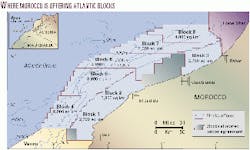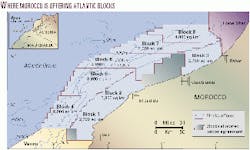Lightly drilled Morocco gears up for more exploration
Exploratory drilling should pick up in Morocco during the next 2 years.
Companies that already hold exploration or reconnaissance rights in Morocco include Shell, Lasmo, Enterprise, Conoco, Kerr-McGee, Vanco, Energy Africa, Taurus, Vanguard (formerly Cabre), Lone Star, and Samir.
Morocco's state Onarep opened a bidding round for 3 shelf blocks and 8 deepwater blocks in the Atlantic Ocean between Rabat and Safi. The round opened Oct. 30. It will close Apr. 30, 2001, and successful companies are to be announced by July 30.
Onarep Director-General Amina Benkhadra said the decision to launch the round now "is based on the interpretation of 7,750 km of seismic shot earlier this year. The seismic data provides good indication of prospective deepwater and shallow-water plays. And in addition, we have significantly reduced the tax burden."
Exploration prospects
The country has 620,000 sq km of sedimentary basins, and drilling density there is 0.04 well/100 sq km, compared with a world density of 8 wells/100 sq km.
Only 26 exploratory wells have been drilled offshore along a 3,500-km coastline, none of them in deep water.
Onarep pointed out the recent acquisition of 26,290 km of seismic data in Morocco, including 25,750 km offshore.
TGS-NOPEC Geophysical Co. acquired 7,750 km of speculative seismic and gravity data in early 2000 offshore between Safi and Rabat, 95% of it in deepwater areas, as a basis for the licensing round. The acquisition area extended from near shore to the 3,000 m isobath.
The new seismic data tie to several off-structure deepwater wells drilled in 1976-81 by the scientific Deep Sea Drilling Project. Some of these wells recorded good quality Cretaceous turbidites, Onarep noted.
For instance, DSDP 416A went to 5,815 m in more than 4,000 m of water. It penetrated about 700 m of Cretaceous to Tertiary-aged turbidites. DSDP 547 west of Rabat went to TD of 4,968 m in about 3,500 m of water. Other DSDP wells are reported to have penetrated good quality source rocks, Onarep said.
Plays, economics
Positive results came from seismic interpretation and an economic evaluation of prospects. Interpretation of the newest seismic data by Equipoise Solutions Ltd., London, found the following five play types:
Triassic and Jurassic rotated blocks.
Salt-related closures at the base of the Tertiary and Cretaceous levels.
Pinchouts in Cretaceous.
Paleozoic broad structural closures.
Reef buildups in Jurassic.
A first-pass evaluation showed that all but one of 9 deepwater prospects in the Rabat-Safi area could support a commercial development and that the largest could generate very high returns, reported IHS Energy Group, Houston.
The evaluation was based on an oil price of $20/bbl, 2%/year inflation, and a project start of Jan. 1, 2001. It did not include pre-development costs or exploration risk.
The analysis showed 30 million to 245 million bbl of P50 reserves in each of 3 Paleozoic prospects; 60 million to 1.4 billion bbl in each of 5 Mesozoic structural and stratigraphic prospects; and 82 million bbl in one Mesozoic allochthonous prospect. Without giving details, Onarep said 3 of 5 recently drilled exploratory wells were discoveries, including one in eastern Morocco (OGJ Online, Aug. 30, 2000).
Energy balance
Morocco badly needs the discovery of indigenous hydrocarbons.
It lists combined oil-condensate and gas reserves of 2 million tons of oil equivalent, coal reserves to be depleted in 2001, and hydroelectric potential of 1.2 million tons/year of oil equivalent. Energy consumption was 9.6 million tons/year of oil equivalent in 1999, making Morocco 96% dependent on imported energy.
Morocco imported 7.2 million tons of oil and 3.3 million tons of coal last year.
The country has recently improved its fiscal terms and is beefing up its power generation grid in a move that could provide markets for any gas discovered. The country also needs gas for residential and industrial purposes.

